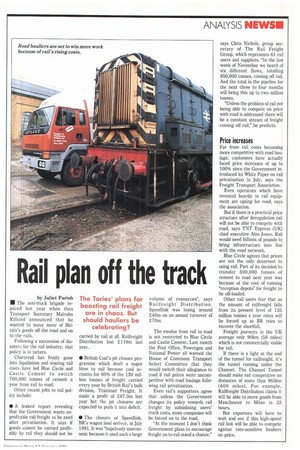Rail plan off the track
Page 19

If you've noticed an error in this article please click here to report it so we can fix it.
by Juliet Parish • The anti-truck brigade rejoiced last year when then Transport Secretary Malcolm Rifkind announced that he wanted to move more of Britain's goods off the road and on to the rails.
Following a succession of disasters for the rail industry, that policy is in tatters.
Charterail has finally gone into liquidation and soaring rail costs have led Blue Circle and Castle Cement to switch 700,000 tonnes of cement a year from rail to road.
• A leaked report revealing that the Government wants unprofitable rail freight to be axed after privatisation. It says if goods cannot be carried profitably by rail they should not be carried by rail at all. Railfreight Distribution lost £119m last year.
• British Coal's pit closure programme which dealt a major blow to rail because coal accounts for 60% of the 120 million tonnes of freight carried every year by British Rail's bulk division, Trainload Freight. It made a profit of £67.5m last year but the pit closures are expected to push it into deficit.
• The closure of Speedlink, BR's wagon load serivce, in July 1991. It was "hopelessly uneconomic because it used such a large volume of resources", says Railfreight Distribution. Speedlink was losing around £40m on an annual turnover of £70m.
The exodus from rail to road is not restricted to Blue Circle and Castle Cement. Last month the Post Office, Powergen and National Power all warned the House of Commons Transport Select Committee that they would switch their allegiance to road if rail prices were uncompetitive with road haulage following rail privatisation.
Even rail's supporters agree that unless the Government changes its policy towards rail freight by subsidising users' track costs, more companies will be forced on to the road.
"At the moment I don't think Government plans to encourage freight on to rail stand a chance," says Chris Nichols, group secretary of The Rail Freight Group, which represents 61 rail users and suppliers. "In the last week of November we heard of six different flows, totalling 850,000 tonnes, coming off rail. And the total in the pipeline for the next three to four months will bring this up to two million tonnes.
"Unless the problem of rail not being able to compete on price with road is addressed there will be a constant stream of freight coming off rail," he predicts.
Price increases
Far from rail costs becoming more competitive with road hail, lage, customers have actually faced price increases of up to 100% since the Government introduced its White Paper on rai privatisation in July, says the Freight Transport Association.
Even operators which have invested heavily in rail equipment are opting for road, says the association.
But if there is a practical price structure after deregulation rail will not be able to compete with road, says TNT Express (UK) chief executive Alan Jones. Rail would need billions of pounds to bring infrastructure into line with the road network.
Blue Circle agrees that prices are not the only deterrent to using rail. Part of its decision to transfer 500,000 tonnes of cement to road next year was because of the cost of running "reception depots" for freight to be off-loaded.
Other rail users fear that as the amount of railfreight falls from its present level of 135 million tonnes a year rates will be forced up as BR tries to recover the shortfall.
Freight journeys in the UK average only 90km (56 miles) which is not commercially viable for rail.
If there is a light at the end of the tunnel for railfreight, it's the tunnel running under the Channel. The Channel Tunnel should make rail competitive on distances of more than 965km (600 miles). For example, Railfreight Distribution claims it will be able to move goods from Manchester to Milan in 32 hours.
But exporters will have to wait and see if this high-speed rail link will be able to compete against rate-sensitive hauliers on price.












































































